Business Administration: Presentation, Office, and Mail Management
VerifiedAdded on 2020/07/23
|21
|4677
|43
Report
AI Summary
This report delves into various facets of business administration, encompassing crucial areas such as presentation development, effective office management, efficient mail handling procedures, and the dynamics of conducting productive meetings. It meticulously examines best practices for crafting compelling presentations that build credibility and engage audiences, while also addressing the importance of venue selection and logistical considerations. The report further explores essential office systems and procedures, including performance management, conflict resolution strategies, and the significance of health, safety, and security protocols. Additionally, it provides a detailed analysis of mail management, covering topics like handling damaged or suspicious items, and dispatching mail services. Furthermore, the report touches upon the essential elements of meetings, including quorum requirements, venue selection, and the role of the chairperson in facilitating discussions and ensuring productive outcomes. Finally, the report also includes references to support the findings.
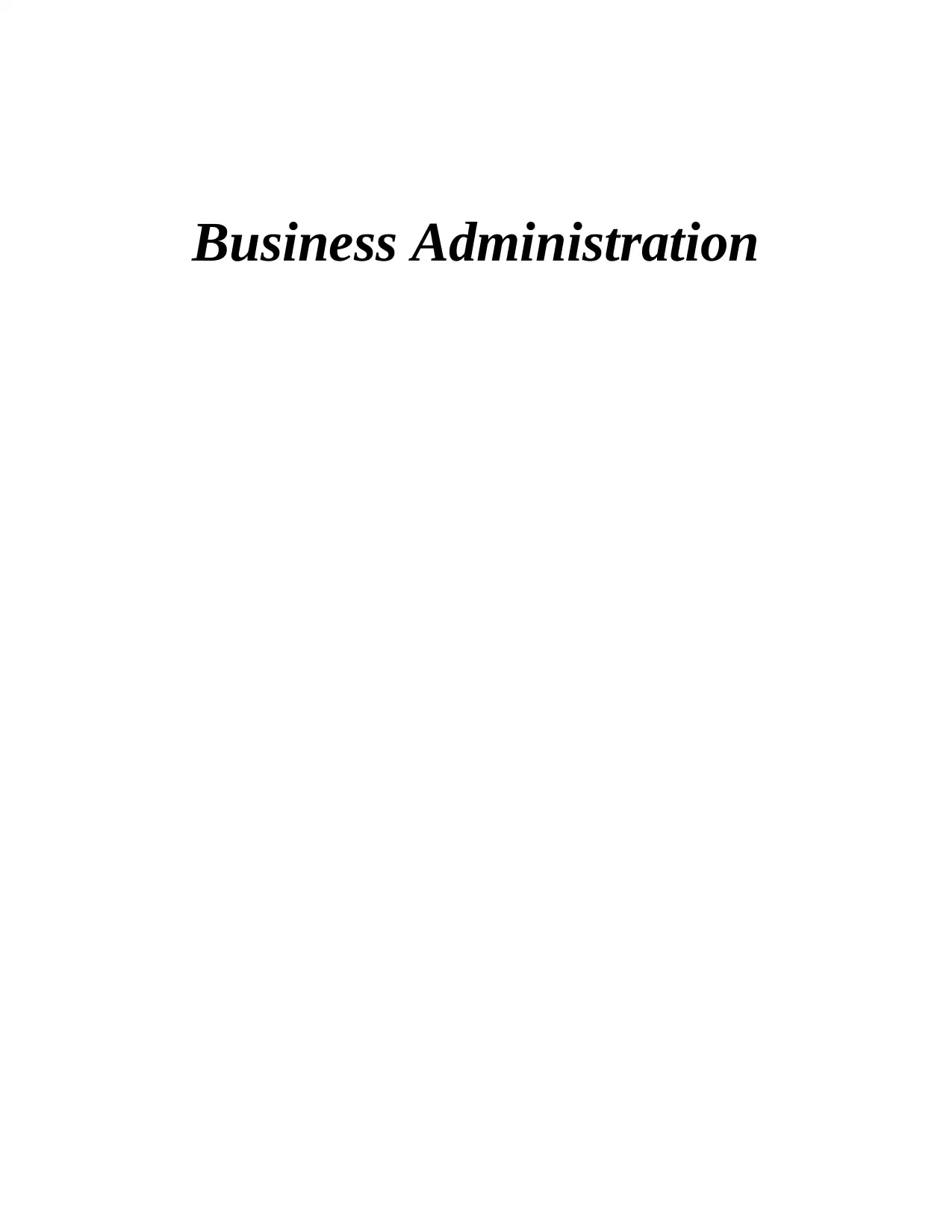
Business Administration
Paraphrase This Document
Need a fresh take? Get an instant paraphrase of this document with our AI Paraphraser
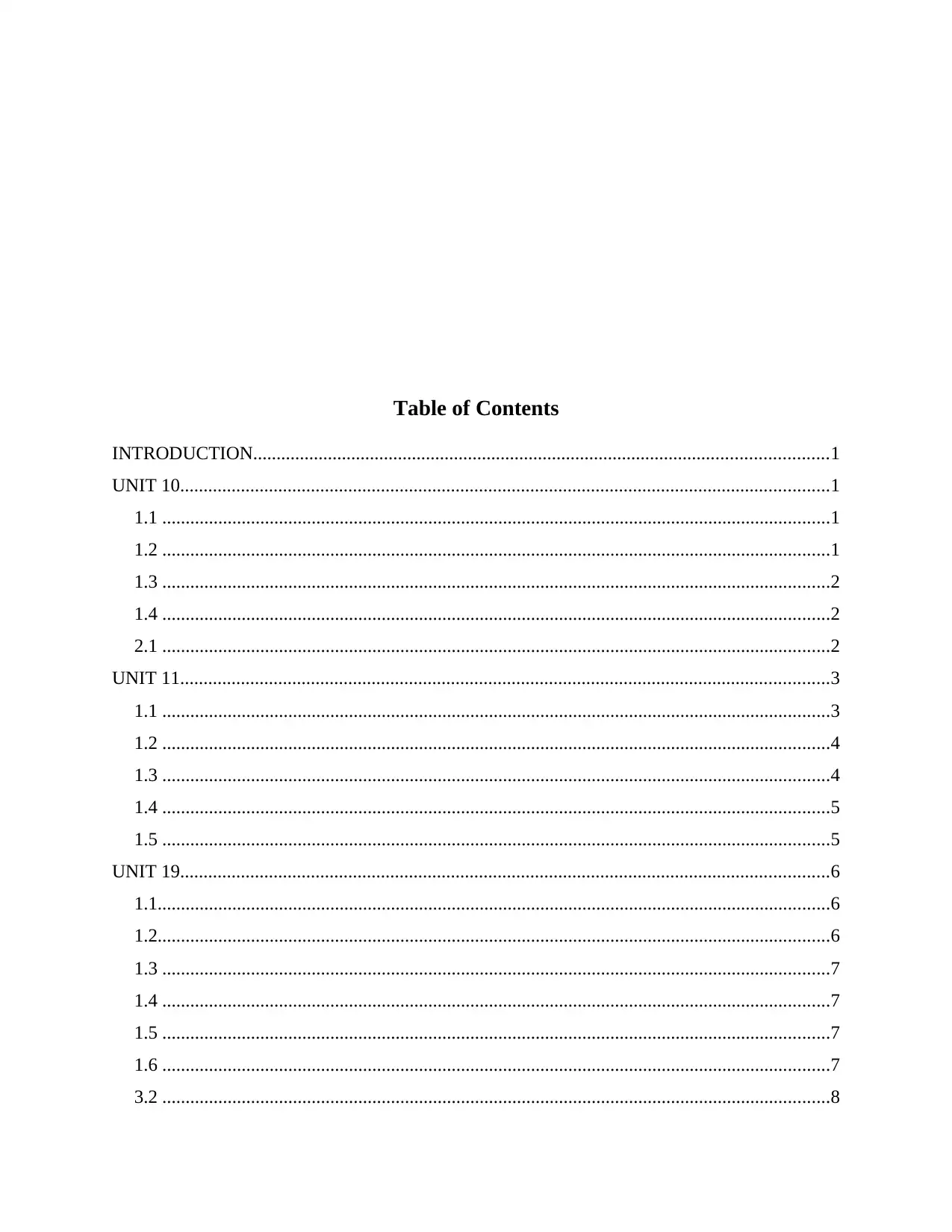
Table of Contents
INTRODUCTION...........................................................................................................................1
UNIT 10...........................................................................................................................................1
1.1 ...............................................................................................................................................1
1.2 ...............................................................................................................................................1
1.3 ...............................................................................................................................................2
1.4 ...............................................................................................................................................2
2.1 ...............................................................................................................................................2
UNIT 11...........................................................................................................................................3
1.1 ...............................................................................................................................................3
1.2 ...............................................................................................................................................4
1.3 ...............................................................................................................................................4
1.4 ...............................................................................................................................................5
1.5 ...............................................................................................................................................5
UNIT 19...........................................................................................................................................6
1.1................................................................................................................................................6
1.2................................................................................................................................................6
1.3 ...............................................................................................................................................7
1.4 ...............................................................................................................................................7
1.5 ...............................................................................................................................................7
1.6 ...............................................................................................................................................7
3.2 ...............................................................................................................................................8
INTRODUCTION...........................................................................................................................1
UNIT 10...........................................................................................................................................1
1.1 ...............................................................................................................................................1
1.2 ...............................................................................................................................................1
1.3 ...............................................................................................................................................2
1.4 ...............................................................................................................................................2
2.1 ...............................................................................................................................................2
UNIT 11...........................................................................................................................................3
1.1 ...............................................................................................................................................3
1.2 ...............................................................................................................................................4
1.3 ...............................................................................................................................................4
1.4 ...............................................................................................................................................5
1.5 ...............................................................................................................................................5
UNIT 19...........................................................................................................................................6
1.1................................................................................................................................................6
1.2................................................................................................................................................6
1.3 ...............................................................................................................................................7
1.4 ...............................................................................................................................................7
1.5 ...............................................................................................................................................7
1.6 ...............................................................................................................................................7
3.2 ...............................................................................................................................................8
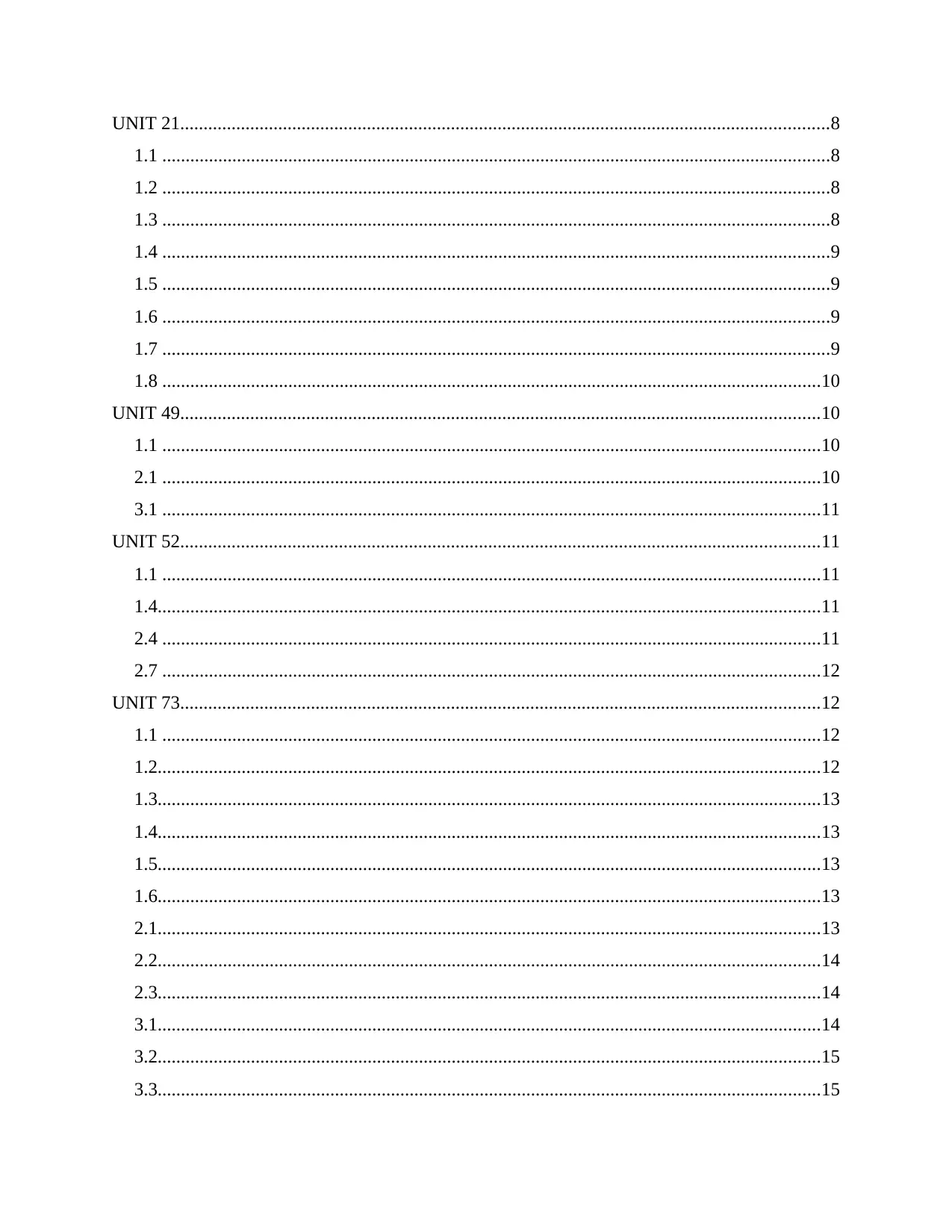
UNIT 21...........................................................................................................................................8
1.1 ...............................................................................................................................................8
1.2 ...............................................................................................................................................8
1.3 ...............................................................................................................................................8
1.4 ...............................................................................................................................................9
1.5 ...............................................................................................................................................9
1.6 ...............................................................................................................................................9
1.7 ...............................................................................................................................................9
1.8 .............................................................................................................................................10
UNIT 49.........................................................................................................................................10
1.1 .............................................................................................................................................10
2.1 .............................................................................................................................................10
3.1 .............................................................................................................................................11
UNIT 52.........................................................................................................................................11
1.1 .............................................................................................................................................11
1.4..............................................................................................................................................11
2.4 .............................................................................................................................................11
2.7 .............................................................................................................................................12
UNIT 73.........................................................................................................................................12
1.1 .............................................................................................................................................12
1.2..............................................................................................................................................12
1.3..............................................................................................................................................13
1.4..............................................................................................................................................13
1.5..............................................................................................................................................13
1.6..............................................................................................................................................13
2.1..............................................................................................................................................13
2.2..............................................................................................................................................14
2.3..............................................................................................................................................14
3.1..............................................................................................................................................14
3.2..............................................................................................................................................15
3.3..............................................................................................................................................15
1.1 ...............................................................................................................................................8
1.2 ...............................................................................................................................................8
1.3 ...............................................................................................................................................8
1.4 ...............................................................................................................................................9
1.5 ...............................................................................................................................................9
1.6 ...............................................................................................................................................9
1.7 ...............................................................................................................................................9
1.8 .............................................................................................................................................10
UNIT 49.........................................................................................................................................10
1.1 .............................................................................................................................................10
2.1 .............................................................................................................................................10
3.1 .............................................................................................................................................11
UNIT 52.........................................................................................................................................11
1.1 .............................................................................................................................................11
1.4..............................................................................................................................................11
2.4 .............................................................................................................................................11
2.7 .............................................................................................................................................12
UNIT 73.........................................................................................................................................12
1.1 .............................................................................................................................................12
1.2..............................................................................................................................................12
1.3..............................................................................................................................................13
1.4..............................................................................................................................................13
1.5..............................................................................................................................................13
1.6..............................................................................................................................................13
2.1..............................................................................................................................................13
2.2..............................................................................................................................................14
2.3..............................................................................................................................................14
3.1..............................................................................................................................................14
3.2..............................................................................................................................................15
3.3..............................................................................................................................................15
⊘ This is a preview!⊘
Do you want full access?
Subscribe today to unlock all pages.

Trusted by 1+ million students worldwide
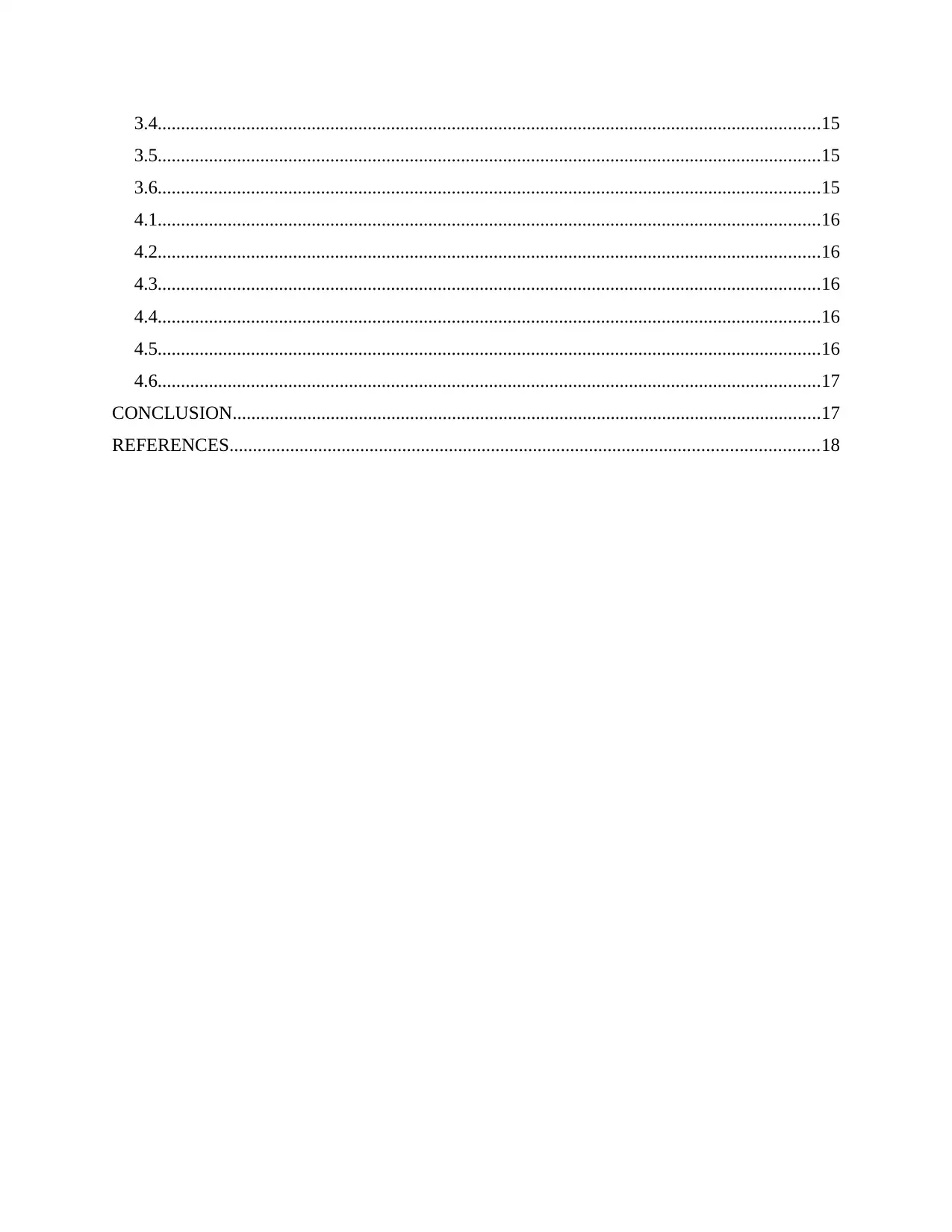
3.4..............................................................................................................................................15
3.5..............................................................................................................................................15
3.6..............................................................................................................................................15
4.1..............................................................................................................................................16
4.2..............................................................................................................................................16
4.3..............................................................................................................................................16
4.4..............................................................................................................................................16
4.5..............................................................................................................................................16
4.6..............................................................................................................................................17
CONCLUSION..............................................................................................................................17
REFERENCES..............................................................................................................................18
3.5..............................................................................................................................................15
3.6..............................................................................................................................................15
4.1..............................................................................................................................................16
4.2..............................................................................................................................................16
4.3..............................................................................................................................................16
4.4..............................................................................................................................................16
4.5..............................................................................................................................................16
4.6..............................................................................................................................................17
CONCLUSION..............................................................................................................................17
REFERENCES..............................................................................................................................18
Paraphrase This Document
Need a fresh take? Get an instant paraphrase of this document with our AI Paraphraser
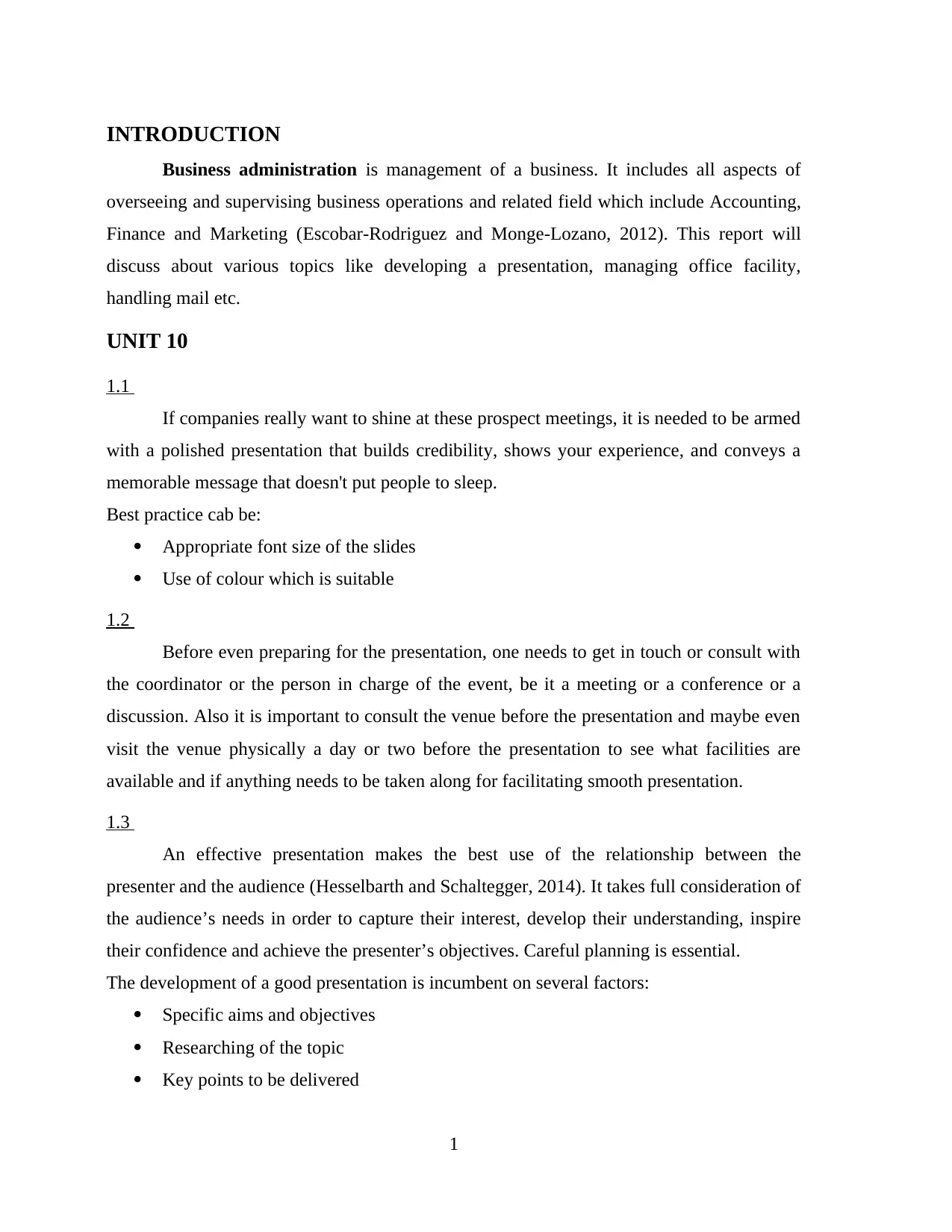
INTRODUCTION
Business administration is management of a business. It includes all aspects of
overseeing and supervising business operations and related field which include Accounting,
Finance and Marketing (Escobar-Rodriguez and Monge-Lozano, 2012). This report will
discuss about various topics like developing a presentation, managing office facility,
handling mail etc.
UNIT 10
1.1
If companies really want to shine at these prospect meetings, it is needed to be armed
with a polished presentation that builds credibility, shows your experience, and conveys a
memorable message that doesn't put people to sleep.
Best practice cab be:
Appropriate font size of the slides
Use of colour which is suitable
1.2
Before even preparing for the presentation, one needs to get in touch or consult with
the coordinator or the person in charge of the event, be it a meeting or a conference or a
discussion. Also it is important to consult the venue before the presentation and maybe even
visit the venue physically a day or two before the presentation to see what facilities are
available and if anything needs to be taken along for facilitating smooth presentation.
1.3
An effective presentation makes the best use of the relationship between the
presenter and the audience (Hesselbarth and Schaltegger, 2014). It takes full consideration of
the audience’s needs in order to capture their interest, develop their understanding, inspire
their confidence and achieve the presenter’s objectives. Careful planning is essential.
The development of a good presentation is incumbent on several factors:
Specific aims and objectives
Researching of the topic
Key points to be delivered
1
Business administration is management of a business. It includes all aspects of
overseeing and supervising business operations and related field which include Accounting,
Finance and Marketing (Escobar-Rodriguez and Monge-Lozano, 2012). This report will
discuss about various topics like developing a presentation, managing office facility,
handling mail etc.
UNIT 10
1.1
If companies really want to shine at these prospect meetings, it is needed to be armed
with a polished presentation that builds credibility, shows your experience, and conveys a
memorable message that doesn't put people to sleep.
Best practice cab be:
Appropriate font size of the slides
Use of colour which is suitable
1.2
Before even preparing for the presentation, one needs to get in touch or consult with
the coordinator or the person in charge of the event, be it a meeting or a conference or a
discussion. Also it is important to consult the venue before the presentation and maybe even
visit the venue physically a day or two before the presentation to see what facilities are
available and if anything needs to be taken along for facilitating smooth presentation.
1.3
An effective presentation makes the best use of the relationship between the
presenter and the audience (Hesselbarth and Schaltegger, 2014). It takes full consideration of
the audience’s needs in order to capture their interest, develop their understanding, inspire
their confidence and achieve the presenter’s objectives. Careful planning is essential.
The development of a good presentation is incumbent on several factors:
Specific aims and objectives
Researching of the topic
Key points to be delivered
1
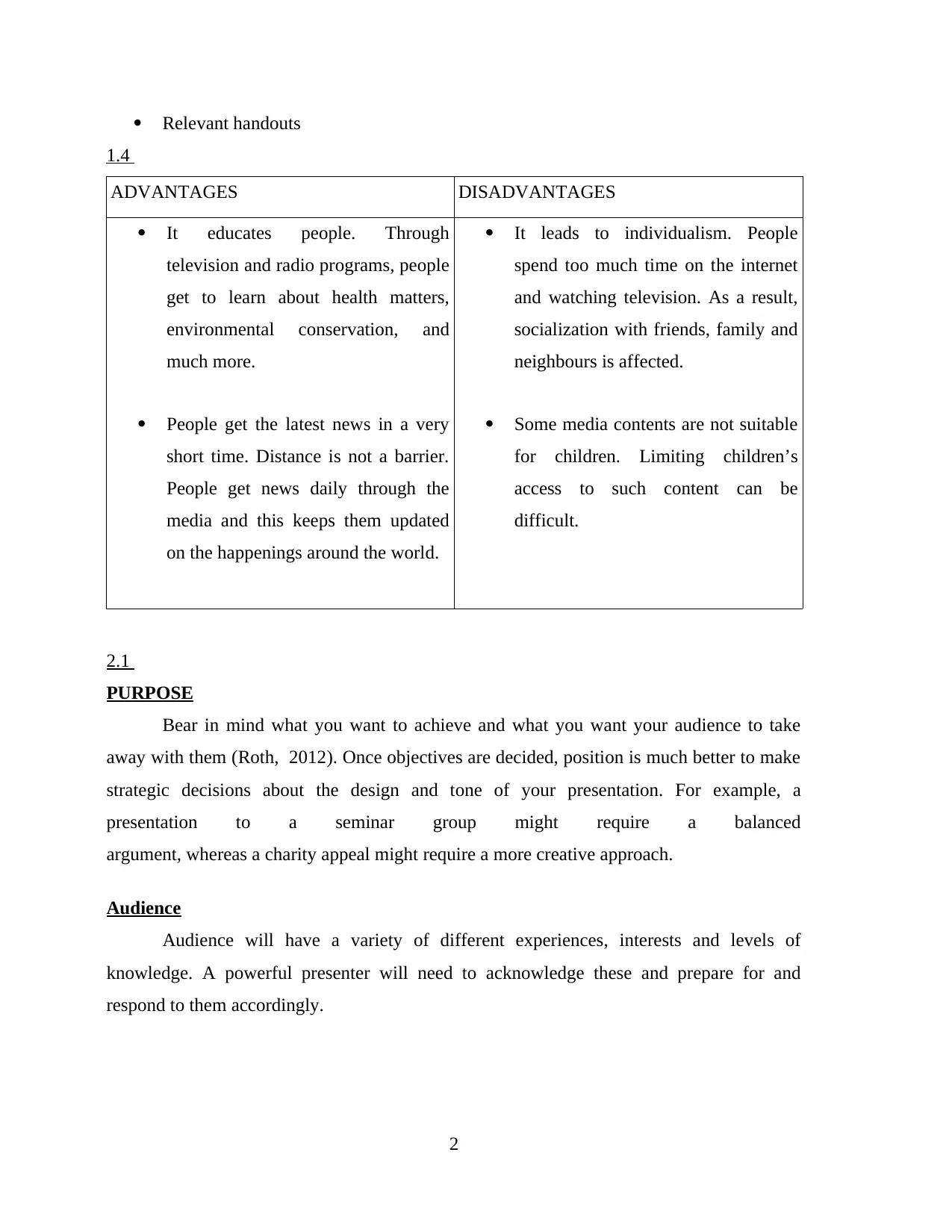
Relevant handouts
1.4
ADVANTAGES DISADVANTAGES
It educates people. Through
television and radio programs, people
get to learn about health matters,
environmental conservation, and
much more.
People get the latest news in a very
short time. Distance is not a barrier.
People get news daily through the
media and this keeps them updated
on the happenings around the world.
It leads to individualism. People
spend too much time on the internet
and watching television. As a result,
socialization with friends, family and
neighbours is affected.
Some media contents are not suitable
for children. Limiting children’s
access to such content can be
difficult.
2.1
PURPOSE
Bear in mind what you want to achieve and what you want your audience to take
away with them (Roth, 2012). Once objectives are decided, position is much better to make
strategic decisions about the design and tone of your presentation. For example, a
presentation to a seminar group might require a balanced
argument, whereas a charity appeal might require a more creative approach.
Audience
Audience will have a variety of different experiences, interests and levels of
knowledge. A powerful presenter will need to acknowledge these and prepare for and
respond to them accordingly.
2
1.4
ADVANTAGES DISADVANTAGES
It educates people. Through
television and radio programs, people
get to learn about health matters,
environmental conservation, and
much more.
People get the latest news in a very
short time. Distance is not a barrier.
People get news daily through the
media and this keeps them updated
on the happenings around the world.
It leads to individualism. People
spend too much time on the internet
and watching television. As a result,
socialization with friends, family and
neighbours is affected.
Some media contents are not suitable
for children. Limiting children’s
access to such content can be
difficult.
2.1
PURPOSE
Bear in mind what you want to achieve and what you want your audience to take
away with them (Roth, 2012). Once objectives are decided, position is much better to make
strategic decisions about the design and tone of your presentation. For example, a
presentation to a seminar group might require a balanced
argument, whereas a charity appeal might require a more creative approach.
Audience
Audience will have a variety of different experiences, interests and levels of
knowledge. A powerful presenter will need to acknowledge these and prepare for and
respond to them accordingly.
2
⊘ This is a preview!⊘
Do you want full access?
Subscribe today to unlock all pages.

Trusted by 1+ million students worldwide
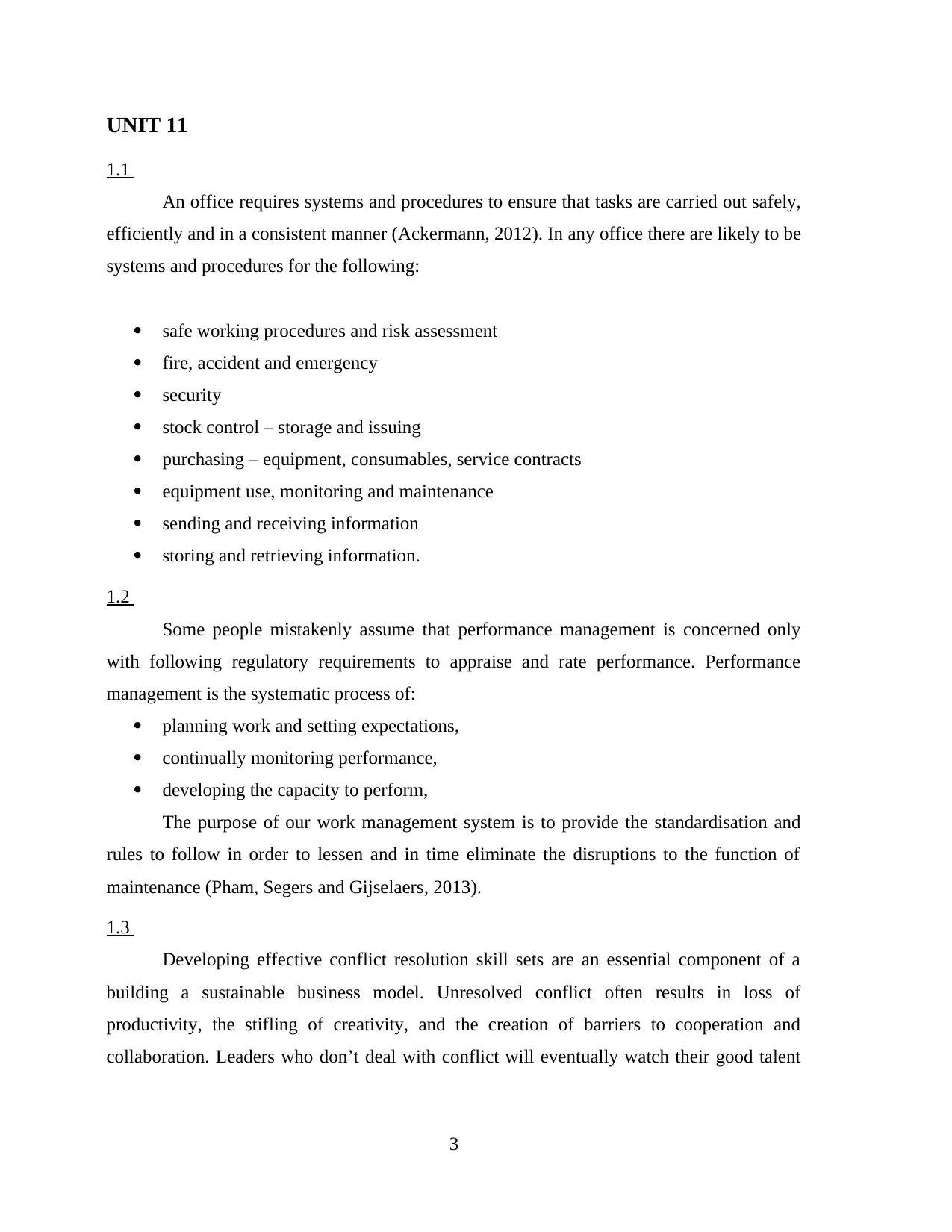
UNIT 11
1.1
An office requires systems and procedures to ensure that tasks are carried out safely,
efficiently and in a consistent manner (Ackermann, 2012). In any office there are likely to be
systems and procedures for the following:
safe working procedures and risk assessment
fire, accident and emergency
security
stock control – storage and issuing
purchasing – equipment, consumables, service contracts
equipment use, monitoring and maintenance
sending and receiving information
storing and retrieving information.
1.2
Some people mistakenly assume that performance management is concerned only
with following regulatory requirements to appraise and rate performance. Performance
management is the systematic process of:
planning work and setting expectations,
continually monitoring performance,
developing the capacity to perform,
The purpose of our work management system is to provide the standardisation and
rules to follow in order to lessen and in time eliminate the disruptions to the function of
maintenance (Pham, Segers and Gijselaers, 2013).
1.3
Developing effective conflict resolution skill sets are an essential component of a
building a sustainable business model. Unresolved conflict often results in loss of
productivity, the stifling of creativity, and the creation of barriers to cooperation and
collaboration. Leaders who don’t deal with conflict will eventually watch their good talent
3
1.1
An office requires systems and procedures to ensure that tasks are carried out safely,
efficiently and in a consistent manner (Ackermann, 2012). In any office there are likely to be
systems and procedures for the following:
safe working procedures and risk assessment
fire, accident and emergency
security
stock control – storage and issuing
purchasing – equipment, consumables, service contracts
equipment use, monitoring and maintenance
sending and receiving information
storing and retrieving information.
1.2
Some people mistakenly assume that performance management is concerned only
with following regulatory requirements to appraise and rate performance. Performance
management is the systematic process of:
planning work and setting expectations,
continually monitoring performance,
developing the capacity to perform,
The purpose of our work management system is to provide the standardisation and
rules to follow in order to lessen and in time eliminate the disruptions to the function of
maintenance (Pham, Segers and Gijselaers, 2013).
1.3
Developing effective conflict resolution skill sets are an essential component of a
building a sustainable business model. Unresolved conflict often results in loss of
productivity, the stifling of creativity, and the creation of barriers to cooperation and
collaboration. Leaders who don’t deal with conflict will eventually watch their good talent
3
Paraphrase This Document
Need a fresh take? Get an instant paraphrase of this document with our AI Paraphraser
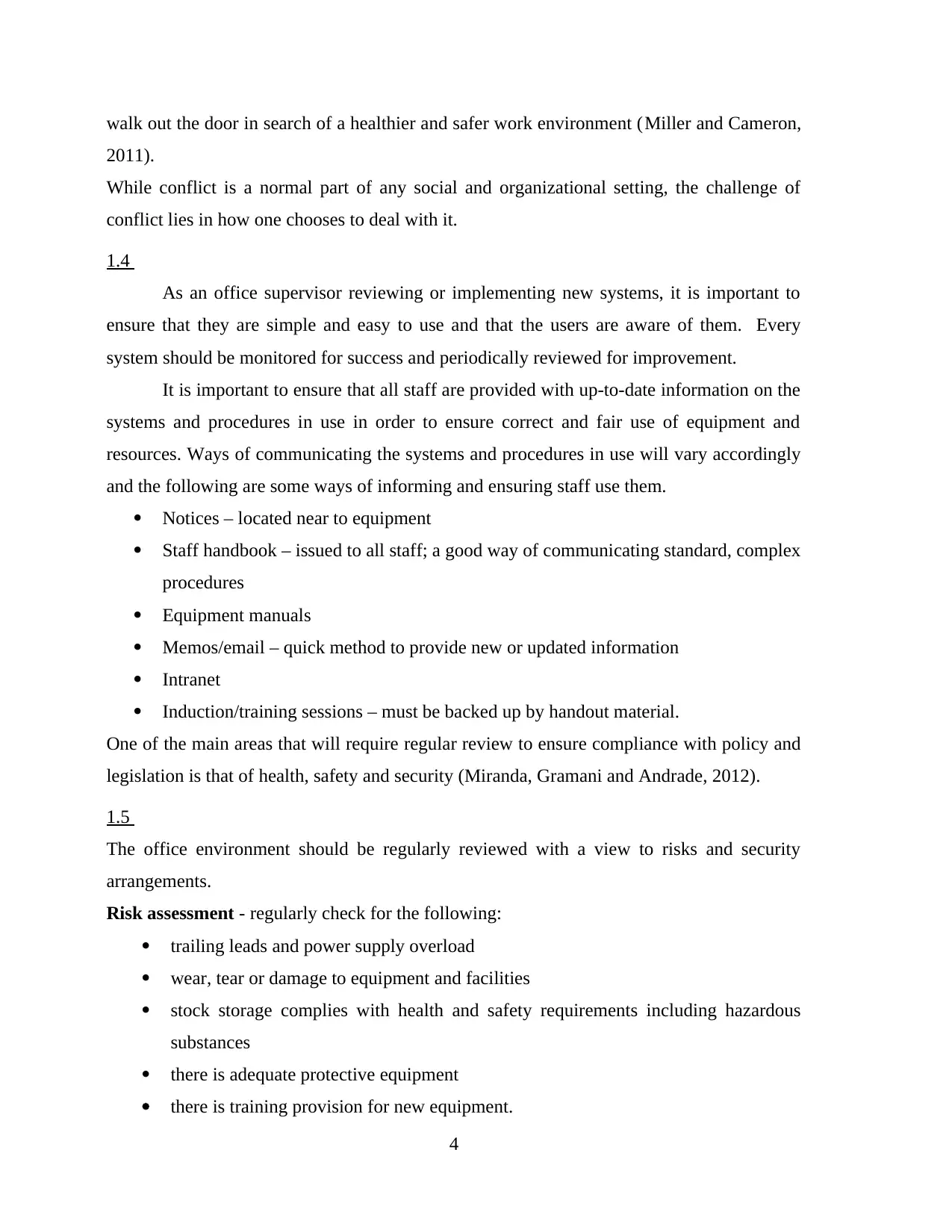
walk out the door in search of a healthier and safer work environment (Miller and Cameron,
2011).
While conflict is a normal part of any social and organizational setting, the challenge of
conflict lies in how one chooses to deal with it.
1.4
As an office supervisor reviewing or implementing new systems, it is important to
ensure that they are simple and easy to use and that the users are aware of them. Every
system should be monitored for success and periodically reviewed for improvement.
It is important to ensure that all staff are provided with up-to-date information on the
systems and procedures in use in order to ensure correct and fair use of equipment and
resources. Ways of communicating the systems and procedures in use will vary accordingly
and the following are some ways of informing and ensuring staff use them.
Notices – located near to equipment
Staff handbook – issued to all staff; a good way of communicating standard, complex
procedures
Equipment manuals
Memos/email – quick method to provide new or updated information
Intranet
Induction/training sessions – must be backed up by handout material.
One of the main areas that will require regular review to ensure compliance with policy and
legislation is that of health, safety and security (Miranda, Gramani and Andrade, 2012).
1.5
The office environment should be regularly reviewed with a view to risks and security
arrangements.
Risk assessment - regularly check for the following:
trailing leads and power supply overload
wear, tear or damage to equipment and facilities
stock storage complies with health and safety requirements including hazardous
substances
there is adequate protective equipment
there is training provision for new equipment.
4
2011).
While conflict is a normal part of any social and organizational setting, the challenge of
conflict lies in how one chooses to deal with it.
1.4
As an office supervisor reviewing or implementing new systems, it is important to
ensure that they are simple and easy to use and that the users are aware of them. Every
system should be monitored for success and periodically reviewed for improvement.
It is important to ensure that all staff are provided with up-to-date information on the
systems and procedures in use in order to ensure correct and fair use of equipment and
resources. Ways of communicating the systems and procedures in use will vary accordingly
and the following are some ways of informing and ensuring staff use them.
Notices – located near to equipment
Staff handbook – issued to all staff; a good way of communicating standard, complex
procedures
Equipment manuals
Memos/email – quick method to provide new or updated information
Intranet
Induction/training sessions – must be backed up by handout material.
One of the main areas that will require regular review to ensure compliance with policy and
legislation is that of health, safety and security (Miranda, Gramani and Andrade, 2012).
1.5
The office environment should be regularly reviewed with a view to risks and security
arrangements.
Risk assessment - regularly check for the following:
trailing leads and power supply overload
wear, tear or damage to equipment and facilities
stock storage complies with health and safety requirements including hazardous
substances
there is adequate protective equipment
there is training provision for new equipment.
4
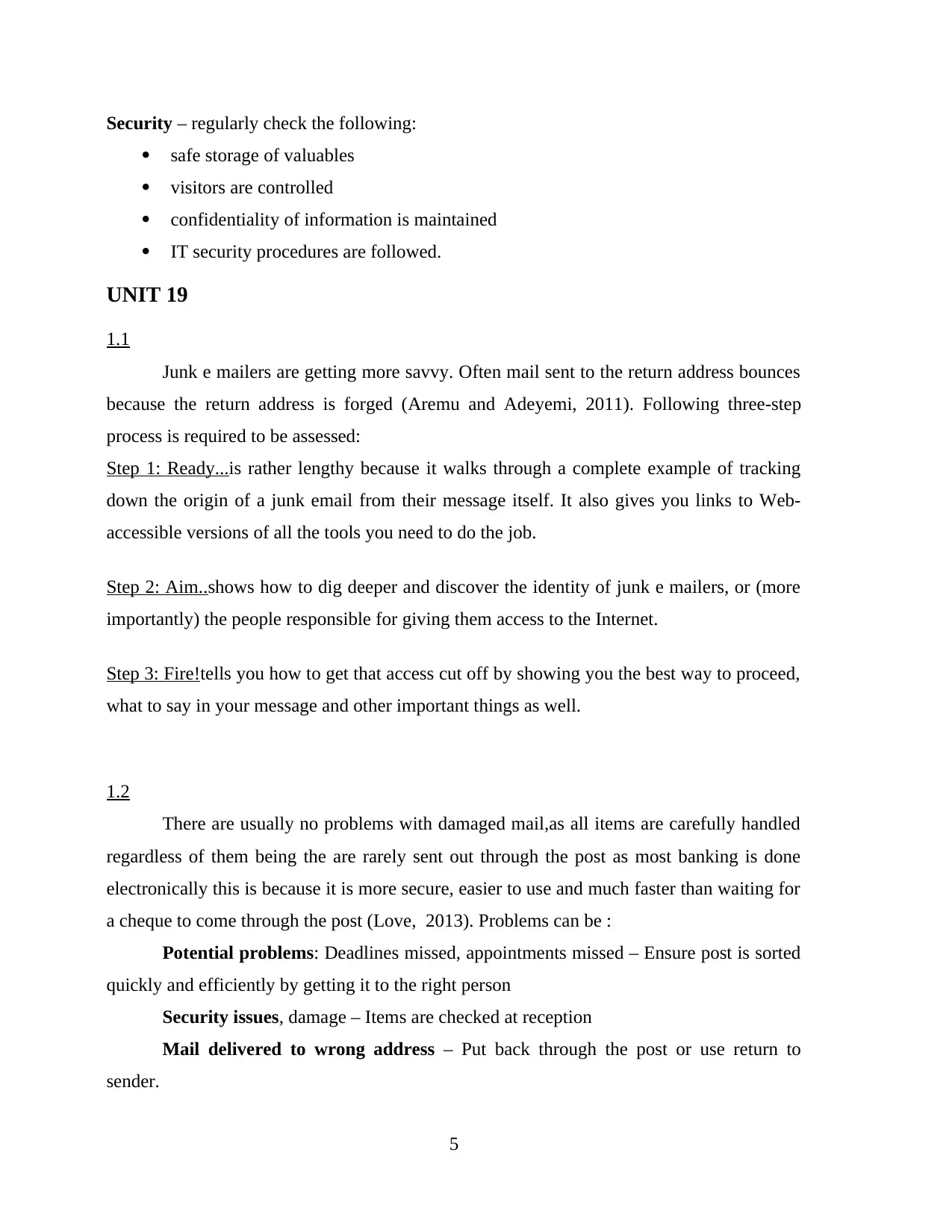
Security – regularly check the following:
safe storage of valuables
visitors are controlled
confidentiality of information is maintained
IT security procedures are followed.
UNIT 19
1.1
Junk e mailers are getting more savvy. Often mail sent to the return address bounces
because the return address is forged (Aremu and Adeyemi, 2011). Following three-step
process is required to be assessed:
Step 1: Ready...is rather lengthy because it walks through a complete example of tracking
down the origin of a junk email from their message itself. It also gives you links to Web-
accessible versions of all the tools you need to do the job.
Step 2: Aim..shows how to dig deeper and discover the identity of junk e mailers, or (more
importantly) the people responsible for giving them access to the Internet.
Step 3: Fire!tells you how to get that access cut off by showing you the best way to proceed,
what to say in your message and other important things as well.
1.2
There are usually no problems with damaged mail,as all items are carefully handled
regardless of them being the are rarely sent out through the post as most banking is done
electronically this is because it is more secure, easier to use and much faster than waiting for
a cheque to come through the post (Love, 2013). Problems can be :
Potential problems: Deadlines missed, appointments missed – Ensure post is sorted
quickly and efficiently by getting it to the right person
Security issues, damage – Items are checked at reception
Mail delivered to wrong address – Put back through the post or use return to
sender.
5
safe storage of valuables
visitors are controlled
confidentiality of information is maintained
IT security procedures are followed.
UNIT 19
1.1
Junk e mailers are getting more savvy. Often mail sent to the return address bounces
because the return address is forged (Aremu and Adeyemi, 2011). Following three-step
process is required to be assessed:
Step 1: Ready...is rather lengthy because it walks through a complete example of tracking
down the origin of a junk email from their message itself. It also gives you links to Web-
accessible versions of all the tools you need to do the job.
Step 2: Aim..shows how to dig deeper and discover the identity of junk e mailers, or (more
importantly) the people responsible for giving them access to the Internet.
Step 3: Fire!tells you how to get that access cut off by showing you the best way to proceed,
what to say in your message and other important things as well.
1.2
There are usually no problems with damaged mail,as all items are carefully handled
regardless of them being the are rarely sent out through the post as most banking is done
electronically this is because it is more secure, easier to use and much faster than waiting for
a cheque to come through the post (Love, 2013). Problems can be :
Potential problems: Deadlines missed, appointments missed – Ensure post is sorted
quickly and efficiently by getting it to the right person
Security issues, damage – Items are checked at reception
Mail delivered to wrong address – Put back through the post or use return to
sender.
5
⊘ This is a preview!⊘
Do you want full access?
Subscribe today to unlock all pages.

Trusted by 1+ million students worldwide
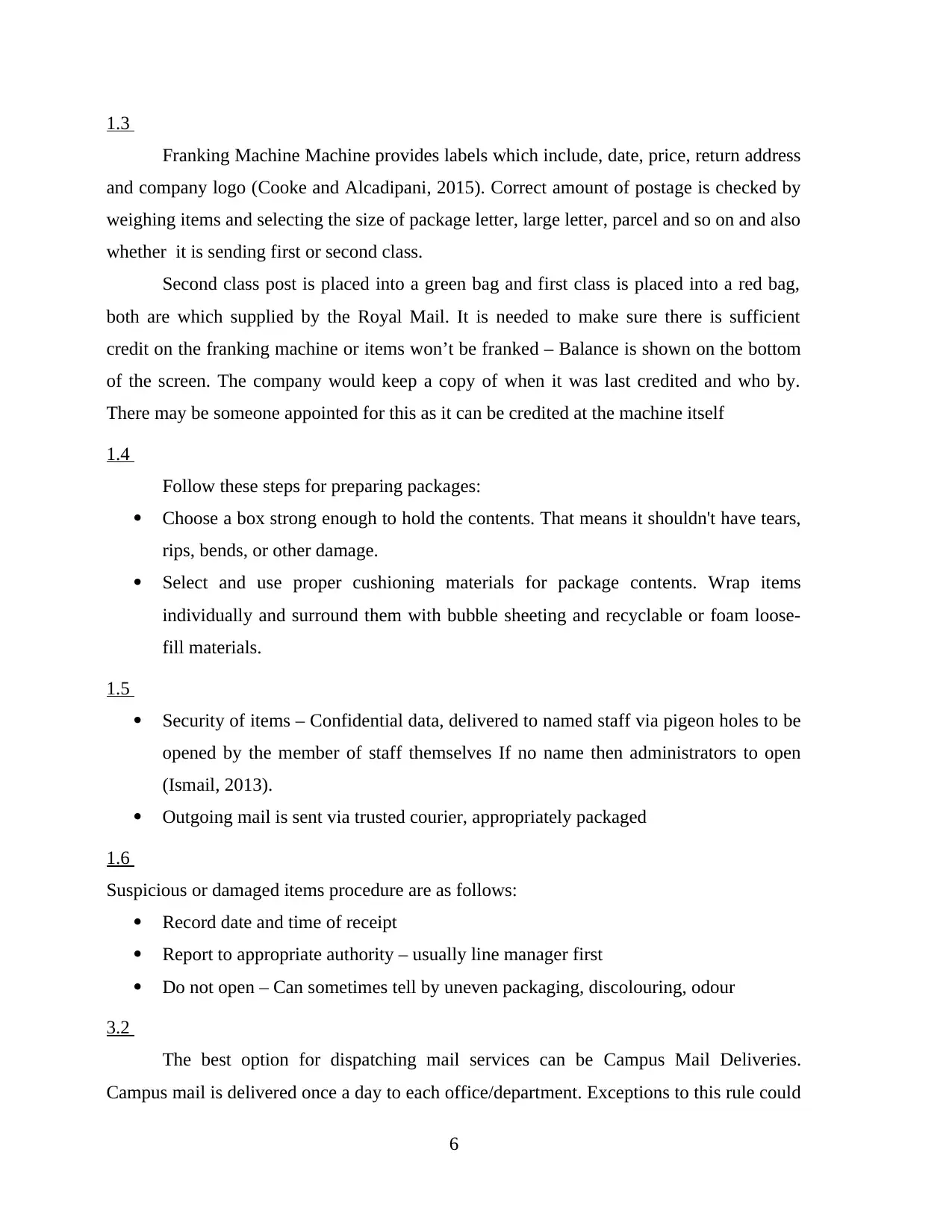
1.3
Franking Machine Machine provides labels which include, date, price, return address
and company logo (Cooke and Alcadipani, 2015). Correct amount of postage is checked by
weighing items and selecting the size of package letter, large letter, parcel and so on and also
whether it is sending first or second class.
Second class post is placed into a green bag and first class is placed into a red bag,
both are which supplied by the Royal Mail. It is needed to make sure there is sufficient
credit on the franking machine or items won’t be franked – Balance is shown on the bottom
of the screen. The company would keep a copy of when it was last credited and who by.
There may be someone appointed for this as it can be credited at the machine itself
1.4
Follow these steps for preparing packages:
Choose a box strong enough to hold the contents. That means it shouldn't have tears,
rips, bends, or other damage.
Select and use proper cushioning materials for package contents. Wrap items
individually and surround them with bubble sheeting and recyclable or foam loose-
fill materials.
1.5
Security of items – Confidential data, delivered to named staff via pigeon holes to be
opened by the member of staff themselves If no name then administrators to open
(Ismail, 2013).
Outgoing mail is sent via trusted courier, appropriately packaged
1.6
Suspicious or damaged items procedure are as follows:
Record date and time of receipt
Report to appropriate authority – usually line manager first
Do not open – Can sometimes tell by uneven packaging, discolouring, odour
3.2
The best option for dispatching mail services can be Campus Mail Deliveries.
Campus mail is delivered once a day to each office/department. Exceptions to this rule could
6
Franking Machine Machine provides labels which include, date, price, return address
and company logo (Cooke and Alcadipani, 2015). Correct amount of postage is checked by
weighing items and selecting the size of package letter, large letter, parcel and so on and also
whether it is sending first or second class.
Second class post is placed into a green bag and first class is placed into a red bag,
both are which supplied by the Royal Mail. It is needed to make sure there is sufficient
credit on the franking machine or items won’t be franked – Balance is shown on the bottom
of the screen. The company would keep a copy of when it was last credited and who by.
There may be someone appointed for this as it can be credited at the machine itself
1.4
Follow these steps for preparing packages:
Choose a box strong enough to hold the contents. That means it shouldn't have tears,
rips, bends, or other damage.
Select and use proper cushioning materials for package contents. Wrap items
individually and surround them with bubble sheeting and recyclable or foam loose-
fill materials.
1.5
Security of items – Confidential data, delivered to named staff via pigeon holes to be
opened by the member of staff themselves If no name then administrators to open
(Ismail, 2013).
Outgoing mail is sent via trusted courier, appropriately packaged
1.6
Suspicious or damaged items procedure are as follows:
Record date and time of receipt
Report to appropriate authority – usually line manager first
Do not open – Can sometimes tell by uneven packaging, discolouring, odour
3.2
The best option for dispatching mail services can be Campus Mail Deliveries.
Campus mail is delivered once a day to each office/department. Exceptions to this rule could
6
Paraphrase This Document
Need a fresh take? Get an instant paraphrase of this document with our AI Paraphraser
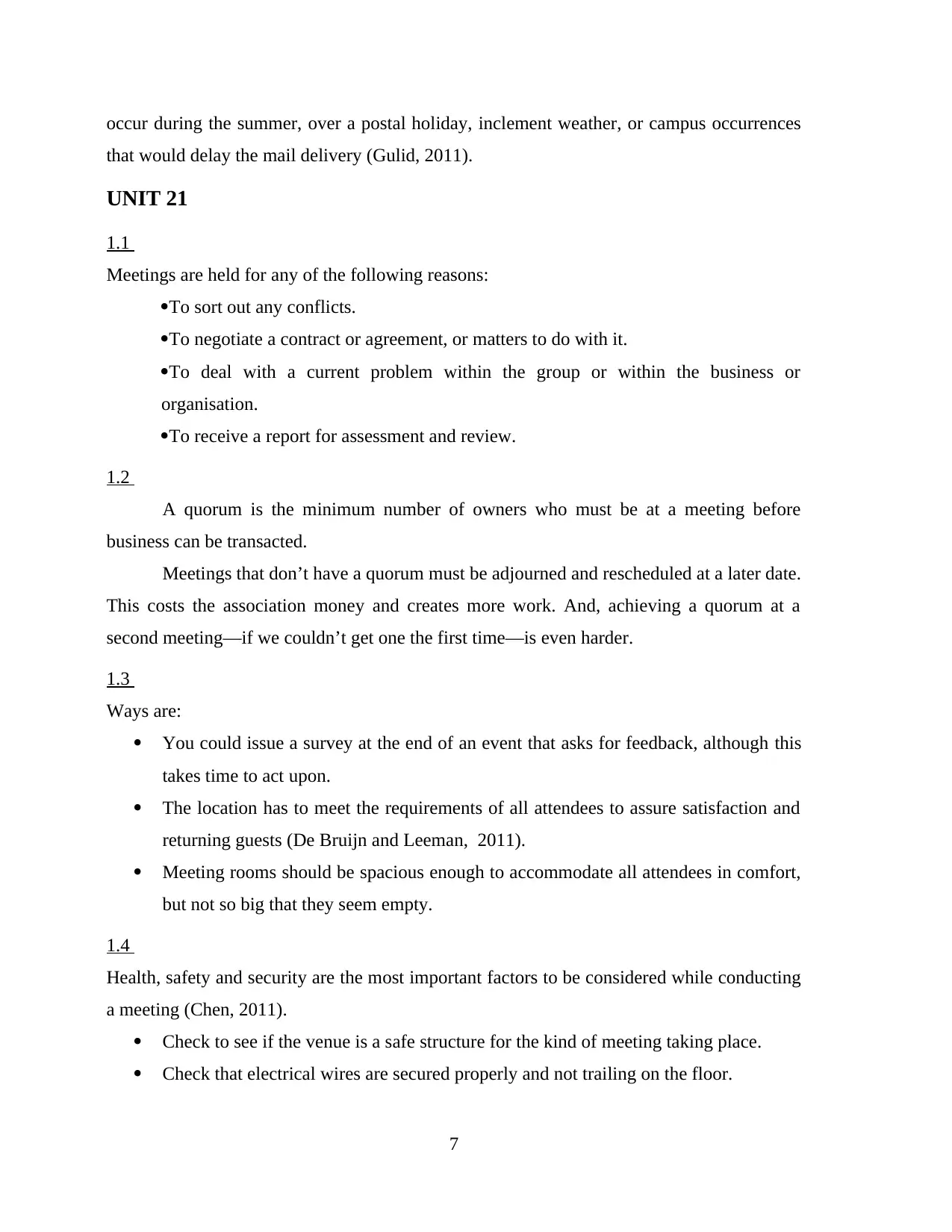
occur during the summer, over a postal holiday, inclement weather, or campus occurrences
that would delay the mail delivery (Gulid, 2011).
UNIT 21
1.1
Meetings are held for any of the following reasons:
To sort out any conflicts.
To negotiate a contract or agreement, or matters to do with it.
To deal with a current problem within the group or within the business or
organisation.
To receive a report for assessment and review.
1.2
A quorum is the minimum number of owners who must be at a meeting before
business can be transacted.
Meetings that don’t have a quorum must be adjourned and rescheduled at a later date.
This costs the association money and creates more work. And, achieving a quorum at a
second meeting—if we couldn’t get one the first time—is even harder.
1.3
Ways are:
You could issue a survey at the end of an event that asks for feedback, although this
takes time to act upon.
The location has to meet the requirements of all attendees to assure satisfaction and
returning guests (De Bruijn and Leeman, 2011).
Meeting rooms should be spacious enough to accommodate all attendees in comfort,
but not so big that they seem empty.
1.4
Health, safety and security are the most important factors to be considered while conducting
a meeting (Chen, 2011).
Check to see if the venue is a safe structure for the kind of meeting taking place.
Check that electrical wires are secured properly and not trailing on the floor.
7
that would delay the mail delivery (Gulid, 2011).
UNIT 21
1.1
Meetings are held for any of the following reasons:
To sort out any conflicts.
To negotiate a contract or agreement, or matters to do with it.
To deal with a current problem within the group or within the business or
organisation.
To receive a report for assessment and review.
1.2
A quorum is the minimum number of owners who must be at a meeting before
business can be transacted.
Meetings that don’t have a quorum must be adjourned and rescheduled at a later date.
This costs the association money and creates more work. And, achieving a quorum at a
second meeting—if we couldn’t get one the first time—is even harder.
1.3
Ways are:
You could issue a survey at the end of an event that asks for feedback, although this
takes time to act upon.
The location has to meet the requirements of all attendees to assure satisfaction and
returning guests (De Bruijn and Leeman, 2011).
Meeting rooms should be spacious enough to accommodate all attendees in comfort,
but not so big that they seem empty.
1.4
Health, safety and security are the most important factors to be considered while conducting
a meeting (Chen, 2011).
Check to see if the venue is a safe structure for the kind of meeting taking place.
Check that electrical wires are secured properly and not trailing on the floor.
7
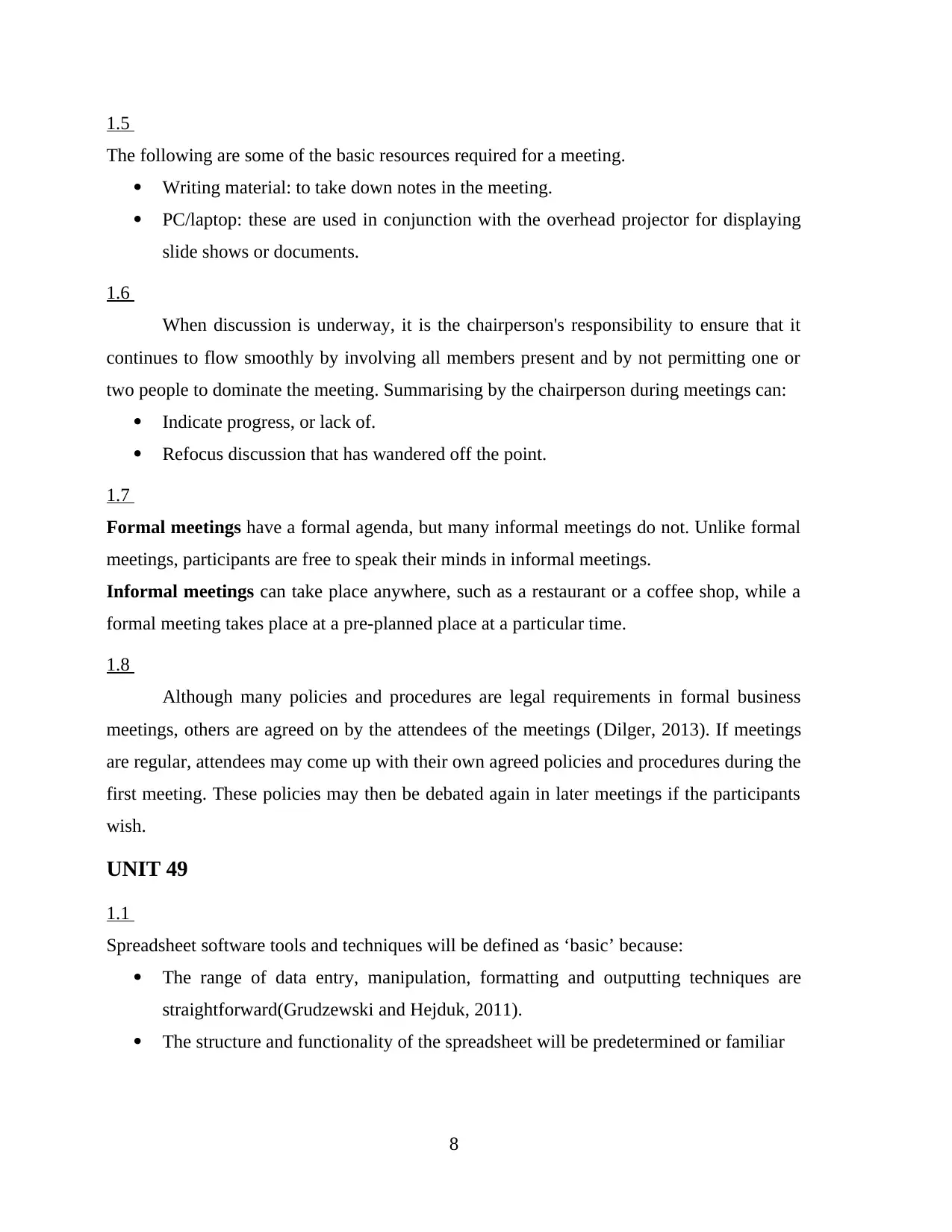
1.5
The following are some of the basic resources required for a meeting.
Writing material: to take down notes in the meeting.
PC/laptop: these are used in conjunction with the overhead projector for displaying
slide shows or documents.
1.6
When discussion is underway, it is the chairperson's responsibility to ensure that it
continues to flow smoothly by involving all members present and by not permitting one or
two people to dominate the meeting. Summarising by the chairperson during meetings can:
Indicate progress, or lack of.
Refocus discussion that has wandered off the point.
1.7
Formal meetings have a formal agenda, but many informal meetings do not. Unlike formal
meetings, participants are free to speak their minds in informal meetings.
Informal meetings can take place anywhere, such as a restaurant or a coffee shop, while a
formal meeting takes place at a pre-planned place at a particular time.
1.8
Although many policies and procedures are legal requirements in formal business
meetings, others are agreed on by the attendees of the meetings (Dilger, 2013). If meetings
are regular, attendees may come up with their own agreed policies and procedures during the
first meeting. These policies may then be debated again in later meetings if the participants
wish.
UNIT 49
1.1
Spreadsheet software tools and techniques will be defined as ‘basic’ because:
The range of data entry, manipulation, formatting and outputting techniques are
straightforward(Grudzewski and Hejduk, 2011).
The structure and functionality of the spreadsheet will be predetermined or familiar
8
The following are some of the basic resources required for a meeting.
Writing material: to take down notes in the meeting.
PC/laptop: these are used in conjunction with the overhead projector for displaying
slide shows or documents.
1.6
When discussion is underway, it is the chairperson's responsibility to ensure that it
continues to flow smoothly by involving all members present and by not permitting one or
two people to dominate the meeting. Summarising by the chairperson during meetings can:
Indicate progress, or lack of.
Refocus discussion that has wandered off the point.
1.7
Formal meetings have a formal agenda, but many informal meetings do not. Unlike formal
meetings, participants are free to speak their minds in informal meetings.
Informal meetings can take place anywhere, such as a restaurant or a coffee shop, while a
formal meeting takes place at a pre-planned place at a particular time.
1.8
Although many policies and procedures are legal requirements in formal business
meetings, others are agreed on by the attendees of the meetings (Dilger, 2013). If meetings
are regular, attendees may come up with their own agreed policies and procedures during the
first meeting. These policies may then be debated again in later meetings if the participants
wish.
UNIT 49
1.1
Spreadsheet software tools and techniques will be defined as ‘basic’ because:
The range of data entry, manipulation, formatting and outputting techniques are
straightforward(Grudzewski and Hejduk, 2011).
The structure and functionality of the spreadsheet will be predetermined or familiar
8
⊘ This is a preview!⊘
Do you want full access?
Subscribe today to unlock all pages.

Trusted by 1+ million students worldwide
1 out of 21
Related Documents
Your All-in-One AI-Powered Toolkit for Academic Success.
+13062052269
info@desklib.com
Available 24*7 on WhatsApp / Email
![[object Object]](/_next/static/media/star-bottom.7253800d.svg)
Unlock your academic potential
Copyright © 2020–2025 A2Z Services. All Rights Reserved. Developed and managed by ZUCOL.





